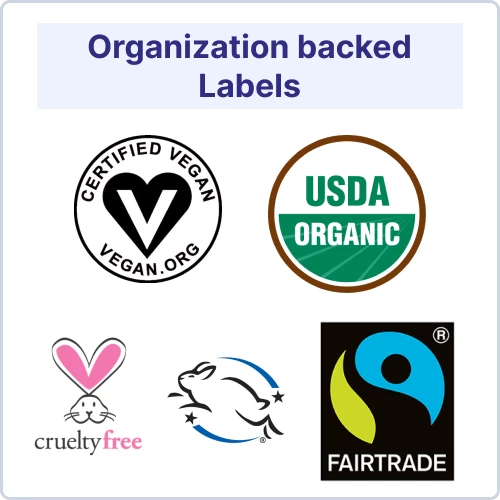Many products have claims such as “vegan”, “natural”, and “cruelty-free”. What do these labels mean?
Here everything you need to know about cosmetic labels. Once you're armed with this knowledge, you'll be able to find the best products for you!
This article will cover:
- What is vegan skincare?
- What is organic skincare?
- What is natural skincare?
- What does cruelty-free mean?
- What does fair-trade mean?
- Fragrance free vs. unscented
- Skincare label claims to watch out for
- Regulations surrounding skincare labels
Authentic Skincare labels
While many skincare products have claims or logos, be sure to keep an eye out for the logos below. These logos are organization backed, meaning the information for the product is verified.

Vegan
To be vegan means an ingredient is not originating from an animal. Non-vegan ingredient examples include egg, shellac, and animal hairs. Some ingredients are controversial for their ‘veganness’, such as snail mucin.
Brands may get certified as vegan by organizations. The term 'vegan' is not defined in many countries and label regulations vary by region.
Organic
Organic can mean an ingredient is derived from a living organism. It can also mean the product is produced without pesticides and other artificial agents.
The FDA does not regulate the word ‘organic’ for packaging. This means products labeled as organic are not held accountable. However, the USDA may certify products to be organic if it meets set standards. If you are looking for organic products, it is best to look out for the USDA organic symbol.
Natural
The word ‘natural’ describes a product using ingredients from natural sources. In other words, nothing artificial or man-made.
Similarly to the term ‘organic’, it is not regulated. While we might assume natural products are better for us, that is not always the case.
To give you an example, I was talking to my friend who is getting a PhD in chemistry about this. Her response? “Cyanide is natural, it can be found in appleseeds!”.
Cruelty-free
Cruelty-free means a company does not harm or test on animals. A company can be certified as cruelty-free from Cruelty Free International and Leaping Bunny.
Many countries have even banned testing on animals altogether. The EU, South Korea, Australia, Mexico, and more have done away with it. As of 2023, Chinese brands can now be certified as cruelty-free. Before, China required certain cosmetics to be tested on animals.
Fair Trade
Fair trade refers to an agreement with producers that promotes equitable and sustainable trade.
Preventing child labor and favorable trade prices also fall under this. You can find if a company is fair trade certified from organizations such as Fair Trade USA.
Fragrance-Free vs Unscented
The EPA has different definitions for these two labels. To be fragrance-free means an ingredients list does not contain any scented ingredients.
To be unscented means to have scent-masking or neutralizing ingredients. Learn more about fragrances here.
Other common and alternative names for fragrance include:
- Perfume
- Parfum
- Essential oil blend
- Aroma
Learn more about the ingredient 'fragrance' or 'parfum'.
General Skin Claims
Many products claim to help with certain skin conditions such as skin brightening or wrinkle reducing. To see if these claims are legitimate, it is best to check the ingredients list and the order.
If a product claims to help with fading dark spots, you should check for ingredients that help with brightening. And these ingredients should be closer to the top of the ingredients list!
Regulations by country
The labeling of cosmetics can differ by country. We recommend checking out your country’s regulations and laws to see how they define specific terms.
A great place to start is your government's official website.
Further Learning
Want to learn more about your favorite product? Check our guide on understanding ingredients lists.